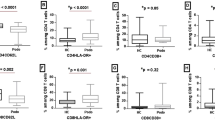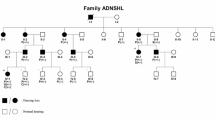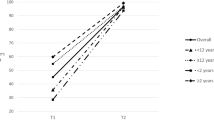Abstract
Background
Previous studies have shown that aberrant T lymphocyte apoptosis is involved in the pathogenesis of uveitis. Genetic variants of apoptotic pathway-related factors (including PDCD1, PDCD1LG2, FAS, and FASLG) may affect apoptosis and in turn predict susceptibility to autoimmune disease. This has not yet been studied in pediatric idiopathic uveitis (PIU) and juvenile idiopathic arthritis (JIA)-associated uveitis and was therefore the subject of the study presented here.
Methods
Fourteen single-nucleotide polymorphisms (SNPs) of several apoptosis-related pathway genes were analyzed in 1238 PIU patients, 128 JIA-associated uveitis patients and 1114 healthy controls using the iPLEX Gold Assay and MassARRAY platform.
Results
A lower frequency of the PDCD1/rs6710479 CC genotype in PIU patients was found when compared to controls (Pc = 3.42 × 10−3). A higher frequency of the PDCD1/rs7421861 A allele (Pc = 4.85 × 10−3) was observed in PIU patients as compared with controls. Stratification analysis showed a positive association of band keratopathy with the PDCD1/rs7565639 CT genotype (Pc = 1.05 × 10−2) and a negative association of this parameter with the PDCD1/rs7565639 C allele (Pc = 3.76 × 10−2).
Conclusions
This study revealed that rs6710479 and rs7421861 in the PDCD1 gene confer susceptibility to PIU in Han Chinese. A stratified analysis showed that PDCD1/rs7565639 is associated with band keratopathy in PIU patients.
Similar content being viewed by others
Log in or create a free account to read this content
Gain free access to this article, as well as selected content from this journal and more on nature.com
or
References
Guly, C. M. & Forrester, J. V. Investigation and management of uveitis. BMJ (Clin. Res. Ed.) 341, c4976 (2010).
Holland, G. N. & Stiehm, E. R. Special considerations in the evaluation and management of uveitis in children. Am. J. Ophthalmol. 135, 867–878 (2003).
Smith, J. A. et al. Epidemiology and course of disease in childhood uveitis. Ophthalmology 116, 1544–1551 (2009). 51.e1.
Angeles-Han, S. T. & Rabinovich, C. E. Uveitis in children. Curr. Opin. Rheumatol. 28, 544–549 (2016).
Elmore, S. Apoptosis: a review of programmed cell death. Toxicol. Pathol. 35, 495–516 (2007).
Zhang, Q., Lenardo, M. J. & Baltimore, D. 30 Years of NF-kappaB: a blossoming of relevance to human pathobiology. Cell 168, 37–57 (2017).
Oeckinghaus, A. & Ghosh, S. The NF-kappaB family of transcription factors and its regulation. Cold Spring Harb. Perspect. Biol. 1, a000034 (2009).
Bally, A. P. et al. NF-kappaB regulates PD-1 expression in macrophages. J. Immunol. 194, 4545–4554 (2015).
Liang, S. C. et al. Regulation of PD-1, PD-L1, and PD-L2 expression during normal and autoimmune responses. Eur. J. Immunol. 33, 2706–2716 (2003).
Contini, P. et al. Apoptosis of antigen-specific T lymphocytes upon the engagement of CD8 by soluble HLA class I molecules is Fas ligand/Fas mediated: evidence for the involvement of p56lck, calcium calmodulin kinase II, and calcium-independent protein kinase C signaling pathways and for NF-kappaB and NF-AT nuclear translocation. J. Immunol. 175, 7244–7254 (2005).
Nagafuchi, H. et al. Aberrant expression of Fas ligand on anti-DNA autoantibody secreting B lymphocytes in patients with systemic lupus erythematosus: “immune privilege”-like state of the autoreactive B cells. Clin. Exp. Rheumatol. 20, 625–631 (2002).
Wan, B. et al. Aberrant regulation of synovial T cell activation by soluble costimulatory molecules in rheumatoid arthritis. J. Immunol. 177, 8844–8850 (2006).
Pittet, C. L., Newcombe, J., Prat, A. & Arbour, N. Human brain endothelial cells endeavor to immunoregulate CD8 T cells via PD-1 ligand expression in multiple sclerosis. J. Neuroinflammation 8, 155 (2011).
Eftekharian, M. M. et al. Expression analysis of long non-coding RNAs in the blood of multiple sclerosis patients. J. Mol. Neurosci. 63, 333–341 (2017).
Yildir, S. et al. Relation of the Fas and FasL gene polymorphisms with susceptibility to and severity of rheumatoid arthritis. Rheumatol. Int. 33, 2637–2645 (2013).
Newby, P. R. et al. Tag SNP screening of the PDCD1 gene for association with Graves’ disease. Clin. Endocrinol. 67, 125–128 (2007).
Chen, S. et al. The associations between PD-1, CTLA-4 gene polymorphisms and susceptibility to ankylosing spondylitis: a meta-analysis and systemic review. Rheumatol. Int. 36, 33–44 (2016).
Lee, Y. H. & Song, G. G. Associations between the FAS -670 A/G, -1377 G/A, and FASL -844 T/C polymorphisms and susceptibility to systemic lupus erythematosus: a meta-analysis. Clin. Exp. Rheumatol. 34, 634–640 (2016).
Ge, J. et al. Association between co-inhibitory molecule gene tagging single nucleotide polymorphisms and the risk of colorectal cancer in Chinese. J. Cancer Res. Clin. Oncol. 141, 1533–1544 (2015).
Eun, Y. G. et al. Single nucleotide polymorphisms of the Fas gene are associated with papillary thyroid cancer. Auris Nasus Larynx 42, 326–331 (2015).
Read, R. W. et al. Revised diagnostic criteria for Vogt-Koyanagi-Harada disease: report of an international committee on nomenclature. Am. J. Ophthalmol. 131, 647–652 (2001).
Yang, P. et al. Development and evaluation of diagnostic criteria for Vogt-Koyanagi-Harada disease. JAMA Ophthalmol. 136, 1025–1031 (2018).
Criteria for diagnosis of Behcet’s disease. International Study Group for Behcet’s Disease. Lancet 335, 1078–1080 (1990).
Petty, R. E. et al. International League of Associations for Rheumatology classification of juvenile idiopathic arthritis: second revision, Edmonton, 2001. J. Rheumatol. 31, 390–392 (2004).
Abelson, A. K. et al. No evidence of association between genetic variants of the PDCD1 ligands and SLE. Genes Immun. 8, 69–74 (2007).
Pizarro, C. et al. PD-L1 gene polymorphisms and low serum level of PD-L1 protein are associated to type 1 diabetes in Chile. Diabetes Metab. Res. Rev. 30, 761–766 (2014).
Forni, D. et al. A 175 million year history of T cell regulatory molecules reveals widespread selection, with adaptive evolution of disease alleles. Immunity 38, 1129–1141 (2013).
Sakthivel, P., Ramanujam, R., Wang, X. B., Pirskanen, R. & Lefvert, A. K. Programmed Death-1: from gene to protein in autoimmune human myasthenia gravis. J. Neuroimmunol. 193, 149–155 (2008).
Xiang, Q. et al. TNF receptor-associated factor 5 gene confers genetic predisposition to acute anterior uveitis and pediatric uveitis. Arthritis Res. Ther. 15, R113 (2013).
Wei, L. et al. MicroRNA-146a and Ets-1 gene polymorphisms are associated with pediatric uveitis. PLoS ONE 9, e91199 (2014).
Chen, L. et al. Constitutive neuronal expression of the immune regulator, programmed death 1 (PD-1), identified during experimental autoimmune uveitis. Ocul. Immunol. Inflamm. 17, 47–55 (2009).
Majewski, J. & Ott, J. Distribution and characterization of regulatory elements in the human genome. Genome Res. 12, 1827–1836 (2002).
Thorne, J. E., Woreta, F., Kedhar, S. R., Dunn, J. P. & Jabs, D. A. Juvenile idiopathic arthritis-associated uveitis: incidence of ocular complications and visual acuity loss. Am. J. Ophthalmol. 143, 840–846 (2007).
Acknowledgements
We thank all participants involved in the present study. This work was supported by “51282” Project for Henan Medical Science and Technology Innovative Talents, Joint Funds of the National Natural Science Foundation of China U1304812 , Medical Scientific and Technological Project of Henan province 201602092 , Scientific and Technological Project of Henan province 172102310374 , Natural Science Foundation Major International (Regional) Joint Research Project 81720108009, and National Natural Science Foundation Project 81770914.
Author information
Authors and Affiliations
Contributions
T.P. and L.D. made substantial contributions to conception and design. F.L., Q.C., and N.L. made substantial contributions to acquisition of data or analysis and interpretation of data. T.P., Y.L., X.M., and L.S. drafted the article and revised it critically for important intellectual content. P.Y. designed this study. P.Y., A.K., and L.D. gave the final approval of the version to be published. All named authors have agreed to its submission. It is not currently being considered for publication by another journal, and if the paper is accepted it will not subsequently be published in the same or similar form in any language without the consent of publishers.
Corresponding author
Ethics declarations
Competing interests
The authors declare no competing interests.
Additional information
Publisher’s note Springer Nature remains neutral with regard to jurisdictional claims in published maps and institutional affiliations.
Supplementary information
Rights and permissions
About this article
Cite this article
Pang, T., Du, L., Li, F. et al. Association of apoptosis genes in PDCD1 but not PDCD1LG2, FAS, and FASLG with pediatric idiopathic uveitis in Han Chinese. Pediatr Res 87, 634–638 (2020). https://doi.org/10.1038/s41390-019-0612-4
Received:
Revised:
Accepted:
Published:
Issue date:
DOI: https://doi.org/10.1038/s41390-019-0612-4



